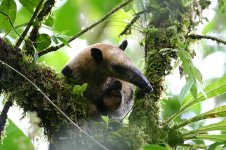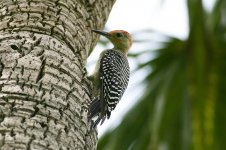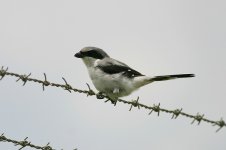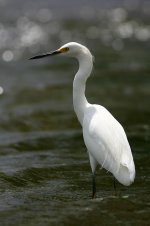
10 September. Braulio Carrillo.
Dawn start yet again, clambering out of the car at the Quebrada Gonzalez Ranger Station, the lower end of Braulio Carrillo. Skies hinted at a dry day, moderately rare on these traditionally wet slopes. Took the trail that wound off up the hill beyond the ranger station, a pair of Ruddy Quail-Doves amongst the first birds seen. This trail turned out to be absolutely fantastic - non-stop birds from start to finish, almost all pure stunners. Stunning a relative word however - among the many good birds, a very healthy dose of furnarids, this creepers and crawlers diversely attired, but all in a shade of brown. Top quality birds with top quality names - Buff-fronted Foliage-Gleaners, Scaly-throated Foliage-Gleaner, Streak-breasted Tree-hunters, Grey-throated Leaftosser, Tawny-throated Leaftosser, Strong-billed Woodcreeper, a tremendous collection. Of all the birds, however, the family that shone above all others on this morning were the tanagers, a most respectable collection, adding colour to virtually every flock encountered. With numbers an absolute minimum, the first couple of hours along this trail was simply tanager heaven: fifteen Black-and-Yellow Tanagers, ten Emerald Tanagers, two Bay-headed Tanagers, four Dusky-faced Tanagers, four Tawny-crested Tanagers, a Speckled Tanager, two Blue-Grey Tanagers and, just to complete the list, at least one Ashy-throated Bush-Tanager, five Common Bush-Tanagers and one male Green Honeycreeper. And of all those tanagers, no less than half were new for the trip!
Reaching the top of the trail, a Green Hermit and male Collared Trogon marked the spot where I decided to return to base, the route back adding near a dozen Tawny-crowned Euphonias, four fly-over Chestnut-billed Toucans and, amazing things at lek, four White-ruffled Manakins. My friend was asleep in the car, so many birds they had missed!
With a glint of sun breaking through, I fancied second helpings on the Snowcaps, so down the road I went and pulled in alongside our friend the strawberry man, another tub duly purchased. And in the butterfly farm, the Verbenia were buzzing - a splendid six Snowcaps on show this morning, four adult males, one immature male and one female, plus several Violet-crowned Woodnymphs, one Rufous-tailed Hummingbird and two Violet-headed Hummingbirds, as well as two Collared Aracari in trees above. With my taste for hummingbird and strawberry satisfied, it was back to ranger station to walk the lower trails. Parked and crossed the road, wandering down the steep slopes that eventually lead down to the raging Rio Sucio. A Red-tailed Squirrel popped out, then flitting Grey-breasted Wood-Wrens, but the first real action took place about half way down with the discovery of a fast-moving flock. Unfortunately, mostly high in the canopy, I missed almost everything, but scrambling to get viewpoints, I eventually caught the tail-end of the birds - ten smart Black-faced Grosbeaks and an assortment of small warbler-types - five Tawny-crowned Greenlets, three Yellow-Green Vireos and, representing the Nearctic, a Black-and-white Warbler and at least four Red-eyed Vireos, also noted seven Scarlet-rumped Caciques just after.
Down steep slippery slopes, admiring Tapir tracks as we went, the forest began to open out, the flood plain of the Rio Sucio hacking its path through the otherwise dense forest. With the change of habitat, Black Phoebes flew sorties from snags, Variable Seedeaters perched up, White-collared Swifts circled overhead. Then, totally unexpected, a nightjar flushed and landed on the track directly ahead. A mottling of browns, buffs and greys, sporting a dark throat and white collar, this large nightjar was a very early returning Chuck Will’s Widow, a bonus indeed. Then it rose again and off it went, gone. With thoughts of the steep climb to return to the car, back we began to plod. Taking an alternative route, we soon bumped into four Crested Guans, but what was encountered next was truly an impressive beastie - rounding a corner, there it lumbered, slowly crossing the path, then shinnying up trunk. It looked like a Womble, a Clanger at a stretch! Last heard of on Wimbledon Common or the moon, here he now resided, this was the mammal of the trip - a super Northern Tamandua, a member of the anteater family and very smart at that.
Did have ideas to spend the late afternoon exploring the higher elevation trails near the road tunnel some kilometres back towards San Jose, but on arrival found it was raining up there, plus I couldn’t find the start of the paths, I presume now overgrown. Not wishing to slop around in dense dripping vegetation, probably seeing nothing, we decided to call it a day.
Returned to Guadpiles, celebrated by visiting the local equivalent of Burger King, then totalled my trip list again - an impressive 16 new species on this day, taking the total to a grand 377. Hmm, could I edge this summer trip to the 400 mark? Just two days left, arghh!
Dawn start yet again, clambering out of the car at the Quebrada Gonzalez Ranger Station, the lower end of Braulio Carrillo. Skies hinted at a dry day, moderately rare on these traditionally wet slopes. Took the trail that wound off up the hill beyond the ranger station, a pair of Ruddy Quail-Doves amongst the first birds seen. This trail turned out to be absolutely fantastic - non-stop birds from start to finish, almost all pure stunners. Stunning a relative word however - among the many good birds, a very healthy dose of furnarids, this creepers and crawlers diversely attired, but all in a shade of brown. Top quality birds with top quality names - Buff-fronted Foliage-Gleaners, Scaly-throated Foliage-Gleaner, Streak-breasted Tree-hunters, Grey-throated Leaftosser, Tawny-throated Leaftosser, Strong-billed Woodcreeper, a tremendous collection. Of all the birds, however, the family that shone above all others on this morning were the tanagers, a most respectable collection, adding colour to virtually every flock encountered. With numbers an absolute minimum, the first couple of hours along this trail was simply tanager heaven: fifteen Black-and-Yellow Tanagers, ten Emerald Tanagers, two Bay-headed Tanagers, four Dusky-faced Tanagers, four Tawny-crested Tanagers, a Speckled Tanager, two Blue-Grey Tanagers and, just to complete the list, at least one Ashy-throated Bush-Tanager, five Common Bush-Tanagers and one male Green Honeycreeper. And of all those tanagers, no less than half were new for the trip!
Reaching the top of the trail, a Green Hermit and male Collared Trogon marked the spot where I decided to return to base, the route back adding near a dozen Tawny-crowned Euphonias, four fly-over Chestnut-billed Toucans and, amazing things at lek, four White-ruffled Manakins. My friend was asleep in the car, so many birds they had missed!
With a glint of sun breaking through, I fancied second helpings on the Snowcaps, so down the road I went and pulled in alongside our friend the strawberry man, another tub duly purchased. And in the butterfly farm, the Verbenia were buzzing - a splendid six Snowcaps on show this morning, four adult males, one immature male and one female, plus several Violet-crowned Woodnymphs, one Rufous-tailed Hummingbird and two Violet-headed Hummingbirds, as well as two Collared Aracari in trees above. With my taste for hummingbird and strawberry satisfied, it was back to ranger station to walk the lower trails. Parked and crossed the road, wandering down the steep slopes that eventually lead down to the raging Rio Sucio. A Red-tailed Squirrel popped out, then flitting Grey-breasted Wood-Wrens, but the first real action took place about half way down with the discovery of a fast-moving flock. Unfortunately, mostly high in the canopy, I missed almost everything, but scrambling to get viewpoints, I eventually caught the tail-end of the birds - ten smart Black-faced Grosbeaks and an assortment of small warbler-types - five Tawny-crowned Greenlets, three Yellow-Green Vireos and, representing the Nearctic, a Black-and-white Warbler and at least four Red-eyed Vireos, also noted seven Scarlet-rumped Caciques just after.
Down steep slippery slopes, admiring Tapir tracks as we went, the forest began to open out, the flood plain of the Rio Sucio hacking its path through the otherwise dense forest. With the change of habitat, Black Phoebes flew sorties from snags, Variable Seedeaters perched up, White-collared Swifts circled overhead. Then, totally unexpected, a nightjar flushed and landed on the track directly ahead. A mottling of browns, buffs and greys, sporting a dark throat and white collar, this large nightjar was a very early returning Chuck Will’s Widow, a bonus indeed. Then it rose again and off it went, gone. With thoughts of the steep climb to return to the car, back we began to plod. Taking an alternative route, we soon bumped into four Crested Guans, but what was encountered next was truly an impressive beastie - rounding a corner, there it lumbered, slowly crossing the path, then shinnying up trunk. It looked like a Womble, a Clanger at a stretch! Last heard of on Wimbledon Common or the moon, here he now resided, this was the mammal of the trip - a super Northern Tamandua, a member of the anteater family and very smart at that.
Did have ideas to spend the late afternoon exploring the higher elevation trails near the road tunnel some kilometres back towards San Jose, but on arrival found it was raining up there, plus I couldn’t find the start of the paths, I presume now overgrown. Not wishing to slop around in dense dripping vegetation, probably seeing nothing, we decided to call it a day.
Returned to Guadpiles, celebrated by visiting the local equivalent of Burger King, then totalled my trip list again - an impressive 16 new species on this day, taking the total to a grand 377. Hmm, could I edge this summer trip to the 400 mark? Just two days left, arghh!
Last edited:







